|

Excellent Singing
Handel and Rossini from Los Angeles Opera
impress MARIA NOCKIN
In April of 1336, Tamerlano, also known as Tamerlane, Tamburlaine, or Timur the Lame, was born in what is now Uzbekistan. A decendant of Genghis Khan, he attempted to amass a large empire as had his ancestor. After his 1370 coronation in Samarkand, he continued his conquests and invaded the Ottoman Empire then ruled by Sultan Bajazet, also known as Beyazit the Thunderbolt. In 1402, he captured the unfortunate Sultan who died after a year of captivity, possibly by his own hand. Tamerlano went on to attempt the invasion of China, but instead he caught a debilitating fever, most likely the plague, and died of it in 1405. Many artists have found this story interesting and it has appeared as a play by Christopher Marlowe, a poem by Edgar Allan Poe and operas by Francesco Gasparini, Antonio Vivaldi and Georg Frideric Handel.
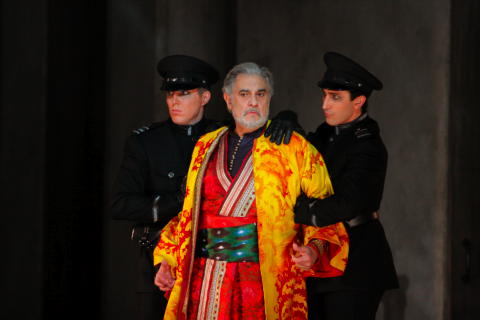
Plácido Domingo as Bajazet in Los Angeles Opera's 'Tamerlano'. Photo © 2009 Robert Millard
|
On Saturday afternoon 28 November 2009, Los Angeles Opera presented Georg Frederic Handel's Tamerlano at the Dorothy Chandler Pavilion. Premièred in 1724, it is one of the first operas to feature a tenor in a leading role. The part of Bajazet was written for one of the best known singers of his time, Francesco Borosini. Thus, it was a perfect role for the dramatic tenor superstar of our age, Plácido Domingo. As was usual in the eighteenth century, Handel wrote the title role of Tamerlano for a castrato. Casting a tenor as his opponent was definitely thinking outside the box, and in all probability it only happened because of the availability of Borosini.
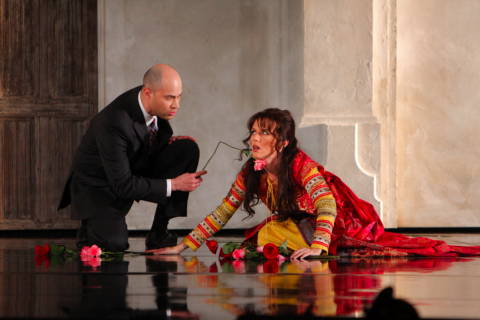
Bejun Mehta as Tamerlano and Sarah Coburn as Asteria in Los Angeles Opera's 'Tamerlano'. Photo © 2009 Robert Millard
|
Chas Rader-Shieber directed the singing actors in a realistic rendition of the opera's situations. Designer David Zinn dressed Tamerlano and most of the cast in modern clothing, but Bajazet and his daughter, Asteria, were resplendent in period outfits. The scenery and furnishings were sparse but effective.
All of the singing was excellent on this occasion. Domingo handled his coloratura with ease while giving a powerful and passionate dramatic rendition of Bajazet's last days. The last act arioso in which he addresses Asteria was monumentally moving. The Asteria, Sarah Coburn, was a beautiful creature dropped into an impossible situation and she was made to look the part of a princess. Hers was the only truly clear, high voice and her razor sharp coloratura dazzled the audience with its radiance.
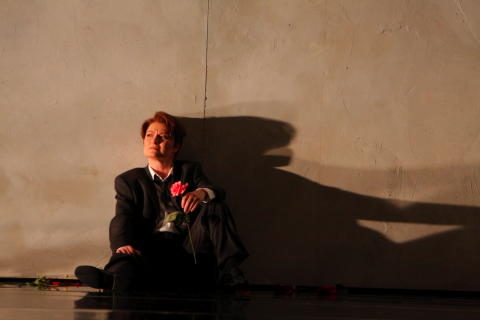
Patricia Bardon as Andronico in Los Angeles Opera's 'Tamerlano'. Photo © 2009 Robert Millard
|
Bejun Mehta has long been one of opera's most esteemed countertenors and his art is in demand around the world. His Tamerlano was a tyrant who let you know that he killed with no compunction whatsoever while he sang with courtly phrasing and decorated his lines with resplendent ornamentation. As Andronico, Irish mezzo-soprano Patricia Bardon sang with a rich agile voice and gave a fine rendition of the role designed for the castrato, Senesino.
The most surprising contribution of the afternoon came from the Leone, bass-baritone Ryan McKinny. Somewhat familiar as Montano from the Los Angeles Otello and the Herald from the recent Houston Lohengrin, his fast, furious and totally accurate coloratura was a revelation. We need to hear a great deal more from him. Mezzo-soprano Jennifer Holloway was a business-like Irene. She sang competently, but her sound could have been more distinctive.
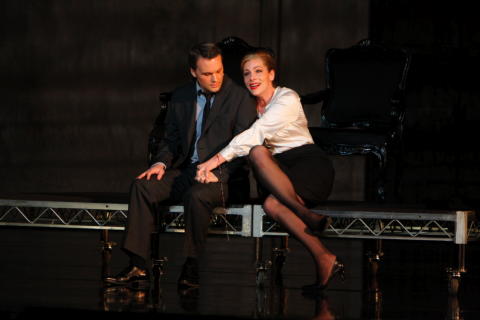
Ryan McKinny as Leone and Jennifer Holloway as Irene in Los Angeles Opera's 'Tamerlano'. Photo © 2009 Robert Millard
|
Conductor William Lacy did a magnificent job of reconstructing this ancient score, not all of which was originally written down. His recitative playing was lucid and his pacing lively. He drew transparent sounds from his instrumentalists while affording the singers every consideration. With this début performance, Lacy gave the audience an idea of what he can do with period opera. We can hope he will be asked to do more of it in Los Angeles.
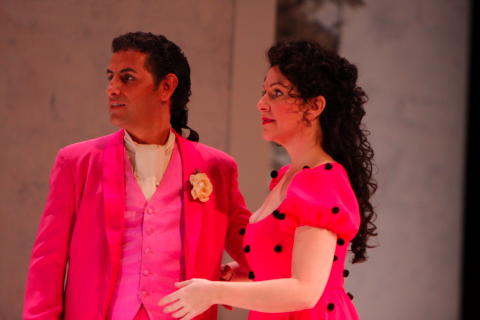
Juan Diego Florez as Almaviva and Joyce DiDonato as Rosina in Los Angeles Opera's 'The Barber of Seville'. Photo © 2009 Robert Millard
|
Like the story of Tamerlano and Bajazet, the tale told by Pierre-Augustin Caron de Beaumarchais in his play, Le Barbier de Séville, has been seen in several guises. Both Giovanni Paisiello and Gioachino Rossini wrote operas that use it as the basis for their librettos. Los Angeles Opera's presentation of the Rossini opera on Sunday 29 November 2009, featured a star-studded cast including the débuts of the world famous coloratura tenor, Juan Diego Florez and the equally renowned mezzo-soprano, Joyce DiDonato.
The production by Emilio Sagi was from the Teatro Real in Madrid in a co-production with the Teatro San Carlos of Lisbon. Javier Ulacia directed in LA. What made this staging unusual was that the villagers and servants all danced their way across the stage to flamenco-styled choreography by Nuria Castejón. Scenic designer Llorenc Corbella made most of his buildings white inside and out while costumer Renata Schlussheim dressed the artists in white with black trim for the first act. Only later did we see any color, but it was absolutely brilliant when it did appear. Lighting designer Eduardo Bravo, too, brought out his colors strongly at the close.
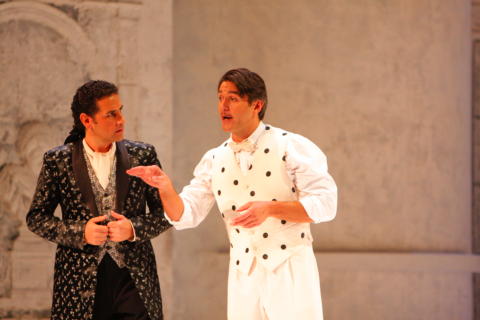
Juan Diego Florez as Almaviva and Nathan Gunn as Figaro in Los Angeles Opera's 'The Barber of Seville'. Photo © 2009 Robert Millard
|
Nathan Gunn was a muscular, energetic and savvy Figaro who sang his speedy 'Largo' with great diction. Anything but a retiring ingenue, right from the beginning DiDonato's Rosina showed her true colors as a lady who has no intention of marrying a man she does not love. Her singing included creamy sensuous tones as well as crisp, agile coloratura. Juan Diego Florez is well known for his astounding ability to sing highly ornamented music. Because of its difficulty, the aria 'Cessa di più resistere' is often cut, but at this performance he sang it gloriously and with seeming ease before carrying his Rosina away in a hot air balloon.
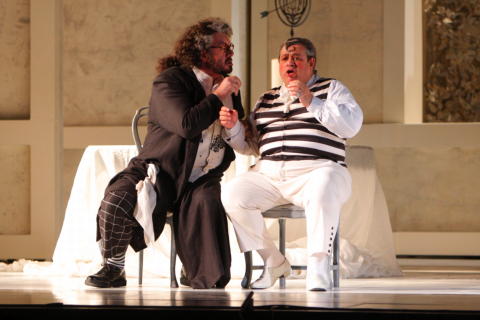
Andrea Silvestrelli as Don Basilio and Bruno Pratico as Doctor Bartolo in Los Angeles Opera's 'The Barber of Seville'. Photo © 2009 Robert Millard
|
Bruno Praticò was a strict and amusing old fogy of a Doctor Bartolo. He also had the fastest patter in his aria, but it was not overly well-projected. As Don Basilio, Andrea Silvestrelli had the largest voice on the stage and his distinctive dark tones made him a most formidable comic villain. Kerri Marcinko's credits include Leonora in Il trovatore and the title role in Tosca, making her casting as Berta something of a surprise. Actually, her soprano sound was a pleasant addition to the ensembles and her ability as a comedienne made her cameo role important. Also to be noted for his vocal and acting ability was the sonorous baritone Jose Adan Perez, who is currently in the Domingo-Thornton Young Artist Program. One can expect to eventually see him in leading baritone roles.
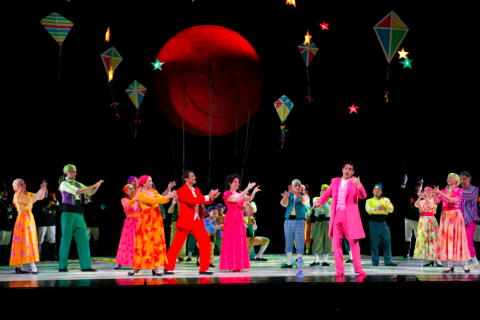
Nathan Gunn as Figaro, Joyce DiDonato as Rosina and Juan Diego Florez as Almaviva in Los Angeles Opera's 'The Barber of Seville'. Photo © 2009 Robert Millard
|
Conductor Michele Mariotti kept the stage and the pit well coordinated in this smartly paced romp through Rossini's music. His sizzling tempi were well matched to the ability of LA Opera's extremely talented and well prepared musicians. They played with infectious verve which blossomed into a finely balanced, propulsive reading of the score. This was a performance that will be remembered by Angelinos and their guests for a very long time.
Copyright © 6 December 2009
Maria Nockin,
Arizona USA

|

